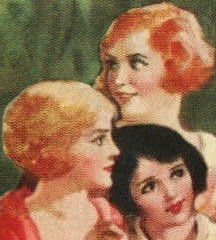 |
The Blythe Girls Series |
|
|
|||
"Where is Helen? What has happened to Helen?" |
|||
|
The Blythe Girls series was published by Grosset and Dunlap from 1925 to 1932 in hardcover with dust jacket. The series was another product of the Stratemeyer Syndicate and was written under the pseudonym of Laura Lee Hope. The name of Laura Lee Hope was already associated with several series for young children, including the Bobbsey Twins and Bunny Brown and His Sister Sue. It is believed that this series was an attempt to associate the author name with books for an older audience. The series was actually written by Elizabeth M. Duffield Ward, who also wrote the Lucile Payton series and volumes 7 through 23 of the Outdoor Girls series. |
|
||
|
|
|||
| The Premise | |||
|
The Blythe Girls series follows the adventures and misfortunes of three sisters, Helen, Margy, and Rose Blythe. All three sisters are in their late teens, with Helen the oldest and Rose the youngest. Helen has blond hair, possesses a quiet and gentle disposition, and is a talented artist who takes after the Blythes' mother. Margy has dark hair, and Margy's primary interest is success in the business world. Margy's ambition leaves her with little time and no patience for men. Rose has blond hair like Helen, but with a reddish tinge. Rose is bubbly and vivacious. Each girl has at least one suitor. Helen's beau is Hugh Draper, a young lawyer who is working hard to make a success of himself. Both Lloyd Roberts and Dale Elton, a reporter, are interested in Margy. Joe Morris, a young man who works for a moving company, is quite taken with Rose. The three girls were forced to move from a nice country home on Long Island to an apartment in New York City after the deaths of their mother and father. Money is a primary concern, and the Blythe sisters struggle for quite some time before Margy and Rose obtain jobs and before Helen gains nominal success with her art. The reader comes to expect trouble, strife, and disaster to confront the Blythe girls at every turn. Shortly after the beginning of each book, something terrible happens to either one or more of the sisters or to one of their close acquaintances. Both Hugh Draper and Joe Morris receive critical injuries in accidents, injuries that threaten to either kill or cripple each man for life. Rose faces the loss of her job several times. Helen loses her paintings by destruction or theft more than once. On one especially disastrous day, a plane crashes into the Blythes' apartment, destroying most of their furniture and forcing them to temporarily live elsewhere. The series also has a recurring villain, Rex Pepper. Rex is the spoiled nephew of Margy's employer, the eccentric Miss Dorcas Pepper. At first, Rex's main vices appear to be his selfishness and arrogance, but in time, it becomes apparent that Rex is a criminal with no compunction. Rex tries repeatedly to steal Miss Pepper's fortune, at one point even trying to have Miss Pepper committed to an insane asylum. Rex often shows up in the most unexpected places and is always involved in an underhanded scheme. |
|||
|
|
|||
| Building a Set | |||
| Unfortunately, this series is difficult to acquire in its entirety. It is not too difficult to obtain the first nine titles in the series in bare books lacking dust jackets, but volumes ten through twelve are very scarce in any condition. However, volume 12 is easier to find than volumes 10 and 11. Thus, this series is an exception to the general rule that the last volume is the scarcest volume. All of the titles in the series are scarce with intact dust jackets, and volumes 10 and 11 are very hard to find with intact dust jackets. | |||
|
|
|||
Cover Art Gallery |
|||
|
|
|||
| Back to Main Page | |||